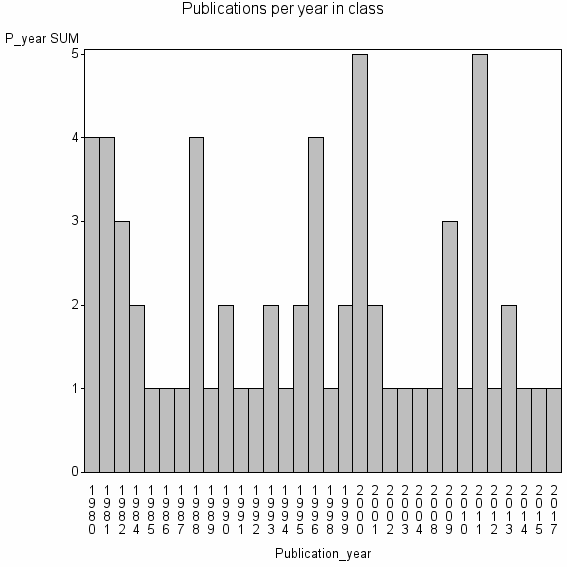
Class information for: |
Basic class information |

Hierarchy of classes |
The table includes all classes above and classes immediately below the current class. |
| Cluster id | Level | Cluster label | #P |
|---|---|---|---|
| 1 | 4 | PHYSICS, CONDENSED MATTER//PHYSICS, APPLIED//MATERIALS SCIENCE, MULTIDISCIPLINARY | 2188495 |
| 215 | 3 | JOURNAL OF CRYSTAL GROWTH//HGCDTE//SOVIET PHYSICS SEMICONDUCTORS-USSR | 51359 |
| 3819 | 2 | SOVIET PHYSICS SEMICONDUCTORS-USSR//SEMICONDUCTORS//OBNINSK BRANCH | 1037 |
| 38371 | 1 | FED SERV TECH EXPORT CONTROL//STATE SCI EXPT TECH INFORMAT PROTECT PRO//AMIRKHANOV PHYS | 63 |
Terms with highest relevance score |
| rank | Category | termType | chi_square | shrOfCwithTerm | shrOfTermInClass | termInClass |
|---|---|---|---|---|---|---|
| 1 | FED SERV TECH EXPORT CONTROL | address | 500272 | 2% | 100% | 1 |
| 2 | STATE SCI EXPT TECH INFORMAT PROTECT PRO | address | 250135 | 2% | 50% | 1 |
| 3 | AMIRKHANOV PHYS | address | 66164 | 8% | 3% | 5 |
| 4 | DAGESTAN SCI | address | 41782 | 13% | 1% | 8 |
| 5 | SOVIET PHYSICS SEMICONDUCTORS-USSR | journal | 32438 | 30% | 0% | 19 |
| 6 | SEMICONDUCTORS | journal | 20853 | 27% | 0% | 17 |
| 7 | PHYSICOTECH | address | 9801 | 6% | 0% | 4 |
| 8 | RADIAT PROBLEMS | address | 4588 | 2% | 1% | 1 |
| 9 | JOURNAL OF COMMUNICATIONS TECHNOLOGY AND ELECTRONICS | journal | 3857 | 8% | 0% | 5 |
| 10 | DAGHESTAN SCI | address | 3521 | 2% | 1% | 1 |
Web of Science journal categories |
| chi_square_rank | Category | chi_square | shrOfCwithTerm | shrOfTermInClass | termInClass |
|---|---|---|---|---|---|
| 1 | Physics, Condensed Matter | 955 | 63% | 0% | 40 |
| 2 | Telecommunications | 167 | 14% | 0% | 9 |
| 3 | Engineering, Electrical & Electronic | 89 | 24% | 0% | 15 |
| 4 | Physics, Applied | 42 | 19% | 0% | 12 |
| 5 | Electrochemistry | 1 | 2% | 0% | 1 |
| 6 | Instruments & Instrumentation | 0 | 2% | 0% | 1 |
Address terms |
| chi_square_rank | term | chi_square | shrOfCwithTerm | shrOfTermInClass | termInClass |
|---|---|---|---|---|---|
| 1 | FED SERV TECH EXPORT CONTROL | 500272 | 2% | 100% | 1 |
| 2 | STATE SCI EXPT TECH INFORMAT PROTECT PRO | 250135 | 2% | 50% | 1 |
| 3 | AMIRKHANOV PHYS | 66164 | 8% | 3% | 5 |
| 4 | DAGESTAN SCI | 41782 | 13% | 1% | 8 |
| 5 | PHYSICOTECH | 9801 | 6% | 0% | 4 |
| 6 | RADIAT PROBLEMS | 4588 | 2% | 1% | 1 |
| 7 | DAGHESTAN SCI | 3521 | 2% | 1% | 1 |
| 8 | PHYS | 11 | 10% | 0% | 6 |
Journals |
| chi_square_rank | term | chi_square | shrOfCwithTerm | shrOfTermInClass | termInClass |
|---|---|---|---|---|---|
| 1 | SOVIET PHYSICS SEMICONDUCTORS-USSR | 32438 | 30% | 0% | 19 |
| 2 | SEMICONDUCTORS | 20853 | 27% | 0% | 17 |
| 3 | JOURNAL OF COMMUNICATIONS TECHNOLOGY AND ELECTRONICS | 3857 | 8% | 0% | 5 |
| 4 | SURFACE ENGINEERING AND APPLIED ELECTROCHEMISTRY | 1576 | 2% | 0% | 1 |
| 5 | RADIOTEKHNIKA I ELEKTRONIKA | 1028 | 5% | 0% | 3 |
| 6 | TECHNICAL PHYSICS LETTERS | 672 | 5% | 0% | 3 |
| 7 | IEEE MICROWAVE AND GUIDED WAVE LETTERS | 594 | 2% | 0% | 1 |
| 8 | IZVESTIYA VYSSHIKH UCHEBNYKH ZAVEDENII RADIOELEKTRONIKA | 565 | 2% | 0% | 1 |
| 9 | PISMA V ZHURNAL TEKHNICHESKOI FIZIKI | 395 | 3% | 0% | 2 |
| 10 | IZVESTIYA VYSSHIKH UCHEBNYKH ZAVEDENII RADIOFIZIKA | 246 | 2% | 0% | 1 |
Author Key Words |
| chi_square_rank | term | chi_square | shrOfCwithTerm | shrOfTermInClass | termInClass | LCSH search | Wikipedia search |
|---|---|---|---|---|---|---|---|
| 1 | LIGHT EMISSION | 1735 | 2% | 0% | 1 | Search LIGHT+EMISSION | Search LIGHT+EMISSION |
| 2 | TUNNELLING | 556 | 2% | 0% | 1 | Search TUNNELLING | Search TUNNELLING |
| 3 | NANOCRYSTALS | 91 | 2% | 0% | 1 | Search NANOCRYSTALS | Search NANOCRYSTALS |
| 4 | QUANTUM DOTS | 38 | 2% | 0% | 1 | Search QUANTUM+DOTS | Search QUANTUM+DOTS |
| 5 | SEMICONDUCTORS | 33 | 2% | 0% | 1 | Search SEMICONDUCTORS | Search SEMICONDUCTORS |
| 6 | POLYMERS | 22 | 2% | 0% | 1 | Search POLYMERS | Search POLYMERS |
Core articles |
The table includes core articles in the class. The following variables is taken into account for the relevance score of an article in a cluster c: (1) Number of references referring to publications in the class. (2) Share of total number of active references referring to publications in the class. (3) Age of the article. New articles get higher score than old articles. (4) Citation rate, normalized to year. |
Classes with closest relation at Level 1 |